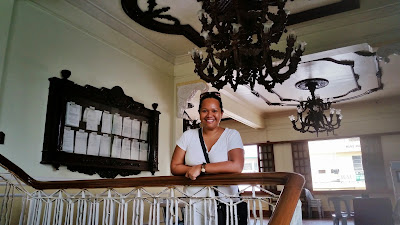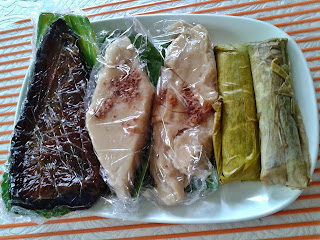I must admit: I would not have gone (or even think about going) to Guagua in Pampanga if not to fulfill a promise that I will visit a good friend and his wonderful mom.
But as an experiential traveler that I am, I always make the most out of my occasional wanderings. I don't just go to a place to check out its tourist spots (and have a photo with it so I can upload them on social media).
I go to a place to better understand it, its people, its history and the things that make it alive. In the process, I get to understand myself better as well. And that is what I got from my visit in Guagua.
 |
| I was transported to the 1940s! |
Blame it on our commercial view of development, but the elegant past of Guagua was hidden behind shops and other money-making establishments. Their municipal hall looks like a white, dull box which lobby is as equally uninviting. So I was really surprised (and thrilled) when I got to its second floor and saw this Commonwealth era interior with all these exquisite wooden chandeliers and ceiling! Photos of some illustrious leaders of the country who were natives of Guagua, like Pedro Gil, were shown. In fact, the house of the revolutionary writer Aurelio Tolentino is actually a few meters away from the municipal hall. It was a bit disappointing though that the house was not maintained as it is rightfully a local heritage.
As a visitor, those supposedly heritage landmarks have already spoken a lot to me about the active role and participation of Guagua in trade and public administration in the earlier times. So I was not surprised when my friend, Richard, told me that Guagua is known for its furniture-making and wood-carving industry. And I also now understand where Richard got his innate leadership abilities.
#2: RAZON'S! San Nicolas cookies and Turones de Casuy! :)
Pampanga is synonymous to good food. Breakfast started with (L-R) kalamay ube (rice pudding with yam), tibok-tibok (a pudding made with carabao's milk), and suman (sweet sticky rice wrapped in banana leaves).
 |
| Woke up to these local delicacies! |
And of course, what is a visit to Guagua without eating at Razon's? I have always loved eating their palabok (noodle topped with pork crackling and thick red orange sauce made from seafood) and halo-halo (ice shaving with sweet banana, coconut meat and custard) combo in Manila. So I wanted to have an authentic experience of the famous delicacies right at its birthplace.
The food was relatively cheap as compared to the big city (which was awesome) but again, it was a shame that Razon's does not have an actual restaurant at its very hometown. With the prestige it has received in the national food industry, it should at least have been given a decent space in the town plaza and not in a tiny location alongside the street.
 |
| On a 40C day, lunch starts with halo-halo. |
Following a Filipino tradition of pasalubong, I was brought by my friend and his mom to La Moderna Bakery, an old bakeshop that opened a few years after the Second World War. They got me the San Nicolas cookies and Turones de Casuy.
San Nicolas cookies reflect the religiosity of the people of Guagua. A typical cookie is molded into an image of the said saint, who was said to have been healed by a bread dipped in water. Turones de Casuy, on the other hand, is a nougat wrapped in rice paper. It seemed to be an adaptation of a Spanish candy-making tradition but this time, it was localized by wrapping it in an edible rice paper. Yes, those white wraps are edible. I tried them.
 |
| Pieces of Guagua to take home with me. |
#3: Its fun-loving people. Again, if not for my friend Richard and his mom, Rose, I would not have set foot on Guagua. It was their positive energy that led me there and made my short visit to Guagua a more meaningful one.
 |
| "Dakal a salamat, Mamee Rose and Richard!" :) |
